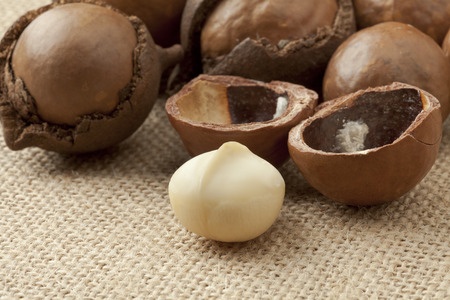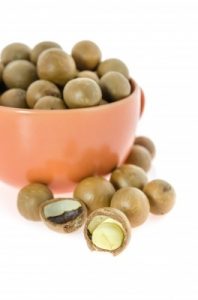
Macadamia nuts are one of the best tasting of all nuts. Anybody visiting the Big Pineapple in Queensland, Australia will have probably bought these nuts as this retailer specialises in macadamia products. They remain extremely popular as a delicious snack. These nuts are also extremely versatile, being used extensively in confectionary, cakes, biscuits (especially cookies) and other baked goods.
The nut comes from one of two sources and is native to Australia. The trees are still to be found in the remnant tropical rain forest belt of the northern part of New South Wales and southern Queensland (Barry and Thomas, 1994; Gross, 1995).
Types Of Macadamia Nuts In Cultivation

There are two species that produce the nut: Macadamia integrifolia (Maiden & Betche) and M. tetraphylla, along with their hybrids (Wallace and Walton, 2011). Other species in the genus produce nuts which are poisonous containing cyanogenic glycosides.
The M. integrifolia has smooth nut shells whilst the M. tetraphylla has rough shells and typically this lends itself to their distinguishing names of smooth-shelled and rough-shelled macadamias. They also have alternative names such as the Queensland Nut, bush nut and nut oak. Both species belong to the Proteaceae family. Typical varieties grown in Hawaii of M. integrifolia include Kau, Keaau, Keauhou and Kakea.
The Macadamia nut was first brought under cultivation in Australia in 1858 and later in Hawaii by the 1880s. Commercially, most of the macadamia nuts are grown from cloned M. Integrifolia. Major growers are in the USA especially Hawaii , Australia, South America and East and South Africa. In the US, it has been the subject of major trading reports because of its economic importance (USITC, 1992) and in East Africa, has now become a valuable export product. Researchers at the University Of Hawaii have reported extensively on its cultivation, processing of the seed and economic viability (Cavaletto, 1983). The International Nut Council (INC) stated the world production of this nut was 26,123 metric tons in 2007/2008. The crop is roughly worth about $52 million in its farm value for 2015.
The kernel, actually the cotyledon, is encased in one of the hardest shells known which in turn is encased in a green leathery outer husk of 2-3 cm diameter. One of the best methods to break the shell open is simply to hit the casing with a mallet or hammer. The nut is made up of two equal halves joined together which often come apart (Ryan, 2006).
Nutritional Value
The kernels contain about 72% of fat (USDA, 2009) where the majority are unsaturated fats (77%), with a predominance of monounsaturated fatty acid including oleic (approximately 59-60%) and the rare omega-7 palmitoleic (approximately 180-20%) acids (Cavaletto, 1983).
Palmitoleic acid is a rather interesting fatty acid in its own right (Hu et al., 2019). This acid appears to have some involvement in endothelial function and cardiac growth but where it has any benefits in ameliorating cardiovascular disease is still to be determined. There may be some association with some types of cancer. The acid may raise insulin sensitivity in muscles. Likewise there may be a reduction in lipogenesis and improvement in insulin sensitivity in the liver.
When compared to cashew and almonds, macadamia nuts have a relatively high total fat content but low protein content. The Macadamia is an important addition to diets where such fats are required (Wood and Garg, 2011).
| Serving Size | 100 Grams (3.5oz.) |
| Energy (kJ) | 3210 kJ |
| Energy (kcal) | 767.19 kcal |
| Fat | 78.7 Grams |
| of which: | |
| – Saturates | 12.8 Grams |
| – Monounsaturates | 63.8 Grams |
| – Polyunsaturates | 2 Grams |
| Carbohydrate | 6.8 Grams |
| of which: | |
| – Sugars | 0 Grams |
| Fibre | 5.6 Grams |
| Protein | 7.9 – 8.1 Grams |
| Salt | 0 Grams |
| Vitamins | |
|---|---|
| Thiamine (B1) |
(104%) 1.195 mg
|
| Riboflavin (B2) |
(14%) 0.162 mg
|
| Niacin (B3) |
(16%) 2.473 mg
|
| Pantothenic acid (B5) |
(15%) 0.76 mg
|
| Vitamin B6 |
(21%) 0.275 mg
|
| Folate (B9) |
(3%) 11 μg
|
| Vitamin C |
(1%) 1.2 mg
|
| Vitamin E |
(4%) 0.54 mg
|
| Minerals | |
| Calcium |
(9%) 85 mg
|
| Iron |
(28%) 3.69 mg
|
| Magnesium |
(37%) 130 mg
|
| Manganese |
(195%) 4.1 mg
|
| Phosphorus |
(27%) 188 mg
|
| Potassium |
(8%) 368 mg
|
| Zinc |
(14%) 1.30 mg
|
Macadamia Nut Oil
Whilst surveying seed oils, I looked at some which deserved further investigation because of their valuable properties in cooking, seasoning and salad oils. Macadamia nut oil is very much one of the best as it retains some of the distinctive nut aroma and serves as replacement for virgin olive oil. Indeed, its monounsaturated fat content is mainly oleic oil which is higher than in olive oil. Its nutritional benefits might be even more beneficial especially in looking after the heart. It contains about 75% w/w fat. The level of ω-6 fatty acids is below 4% and so a combination with fish oil would make it extremely healthy.
Macadamia nut kernels contain a number of anti-oxidants such as tocopherols, tocotrienols and squalene. It is not clear if their presence contributes to the oxidative stability of the kernel.
Storage, Processing And Transport
The quality of Macadamia nuts depends on their initial quality at harvest and especially how well they are stored. It is critical to treat the nut carefully. Poor production and harvest practice produces wide variations in maturity, moisture content, disease and insect damage. Normally the whole nut is delivered as wet-in-shell (WIS) to the processor. Generally, these nuts are dried and roasted to preserve their nutritional quality and develop their unique flavour. The optimum moisture content is below 1.5g/100g. Care must be taken to avoid too much browning during the drying process (Wall and Gentry, 2007).
Hot air-assisted radio frequency drying is a relatively new process for drying Macadamia nuts in their shell (Wang et al., 2014). It produces a more stable product compared to conventional drying methods.
Poor handling of the nut prior to packaging can lead to the presence of food borne diseases such as Listeria which causes Listeriosis. There are frequent occurrences reported in the news of recalls by nut suppliers.
Macadamia Nut Products
Please note this page contains links to our affiliate marketing partner. Please read our affiliate disclosure.
Purchase your Macadamia Nut products here
References
Barry, S.J., Thomas, G.T. (1994) Threatened vascular rainforest plants of South-East Queensland: a conservation review. Brisbane: Queensland Department of Environment and Heritage.
Borompichaichartkul, C., Luengsode, K., Chinprahast, N., & Devahastin, S. (2009). Improving quality of macadamia nut (Macadamia integrifolia) through the use of hybrid drying process. J. Food Engineering, 93, pp. 348–353
Cavaletto, C.G. (1983) Macadamia Nuts. In: Handbook of Tropical Foods. (Edt. H.T. Chan, Jr.) Marcel Dekker, New York pp. 361-397
Gross, C.L. (1995) Macadamia orchard. In: McCarthy, A.E., McCarthy, P.M. editors. Flora of Australia Canberra: ABRS and Melbourne: CSIRO. pp. 419–425
Hu, W., Fitzgerald, M., Topp, B., Alam, M., O’Hare, T.J., (2019) A review of biological functions, health benefits, and possible de novo biosynthetic pathway of palmitoleic acid in macadamia nuts. J. Functional Foods. 62 November, 103520 (Article)
Ryan, S. (2006) Conservation management profile: Queensland nut tree Macadamia integrifolia. [Online]. Queensland: Environmental Protection Agency, Ecosystem Conservation Branch. Available from: http://www.epa.qld.gov.au/publications/p02096aa.pdf/Queensland_nut_tree_emMacadamia_integrifolia/em.pdf. Accessed July 2010.
USDA. (2009) National Nutrient Database for Standard Reference, Release 22. Available at: www.nal.gov/fnic/foodcomp/search. Accessed July, 2012.
USITC (United States International Trading Commission) (1992) Macadamia Nuts: Economic And Competitive factors Affecting The U.S. Industry. Publ. 2573 November. Washington D.C. 20436
Wall, M. M., & Gentry, T. S. (2007). Carbohydrate composition and color development during drying and roasting of macadamia nuts (Macadamia integrifolia). LWT-Food Science and Technology, 40(4), pp. 587-593.
Complex stuff. Love these nuts though. I’ve seen some really bad reviews about the sale of packaged nuts from Whole Foods but I have never had a bad batch. They taste amazing. Macadamias have to be my favourite nut. I like them to a certain extent in granola. They are high in natural fat and great for some one following a more healthy low carb with high fat diet like they suggest. If you roast them in the oven, they taste even better. Really cannot fault them.